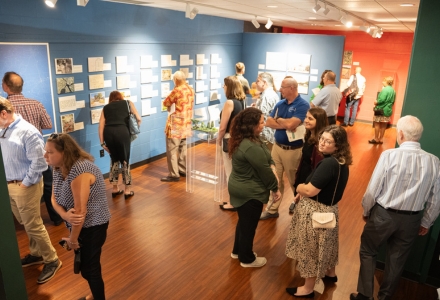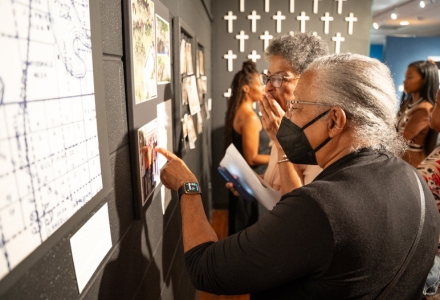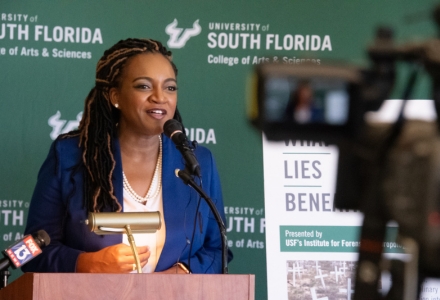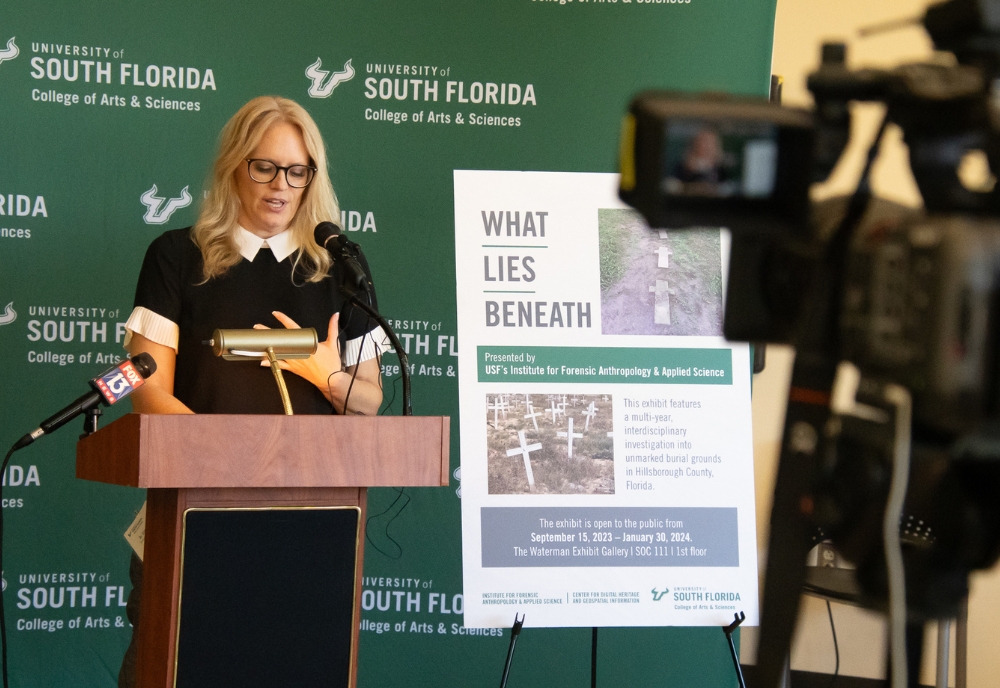The “What Lies Beneath” exhibit located in the Social Sciences (SOC) Waterman Exhibit Gallery at USF shares the results of a multi-year, interdisciplinary investigation into unmarked burial grounds in Hillsborough County.

The What Lies Beneath exhibit is a showcase and exhibit into the investigation of unmarked burial grounds throughout Hillsborough County. (Photo by Corey Lepak)
Dr. Erin Kimmerle, associate professor in the Department of Anthropology, and her doctoral candidate Kelsee Hentschel-Fey, along with Benjamin Mittler, a GIS Project Manager with the Digital Heritage and Humanities Collections at USF Libraries, and Dr. Lori Collins, research associate professor in the School of Geosciences and co-director of the USF Center for Digital Heritage and Geospatial Information, showcase the identification of more than 40 cemeteries and burial grounds.
The exhibit includes mixed media sculptures, historic and modern photographs, archival documents, and maps depicting the approximate locations of newly re-discovered burial grounds in order to help convey the story of the buried past.
In 2019, two African American cemeteries built over in Tampa in the 1950s exemplified this concept; the Zion Cemetery located on Florida Avenue property owned by the Tampa Housing Authority and the Ridgewood Cemetery located on the grounds of King High School owned by the Hillsborough School Board Authority.
The re-discovery of these cemeteries prompted the Hillsborough Board of County Commissioners (HBCC) to question whether there were additional unmarked cemeteries on county owned property, Kimmerle explained. An in-depth investigation into the location of unmarked graves was then undertaken for HBCC.
Kimmerle says that through that research project, a GIS approach used a combination of archival, ethnographic, bioarcheological, remote sensing and forensic archaeological methods to identify possible cemeteries and burials throughout the county.
“Analysis of that data show that at least eighteen or 44% of the sites located are African American, Afro-Cuban, or were classified as ‘colored’ during the era of segregation,” Kimmerle said.
Kimmerle said what set their work apart from archaeology is that it is based in biological and forensic anthropology.
“We first ask the question – who is living here? How did people use the land and move around the area? Where were they from? We need to know who we are looking for when searching for unmarked burial grounds,” Kimmerle said.

Exhibit attendees recognize some of their ancestors in photographs throughout the exhibit. (Photo by Corey Lepak)
The grand opening of the exhibit, held on Sept. 15, featured special guests Magali Michael, CAS interim dean; Dr. Todd Chavez, dean of USF Libraries; Fred Hearns, curator of Black History at the Tampa Bay History Center; Fentrice Driskell, state representative and democratic leader for the Florida House of Representatives; and Christina Arenas, a descendant of those buried at the Keystone Settlement and Cemetery.
Arenas, who has descendants buried in locations highlighted in the exhibit investigation, said her childhood school bus would drop her off on the corner of Gunn Highway and Racetrack Road, all the while driving by areas that she, at the time, did not realize belonged to her ancestors.
“I had idea the bus route was taking me on a tour of land that had belonged to my ancestors for over a century,” Arenas said during the exhibit’s grand opening. “Our ancestors will not be forgotten; we will continue to speak their names. Their stories need to be shared because today I’ve only touched the surface of who they were and what they contributed to the area. Land is sacred and we deserve access to where our ancestors are laid.”
Kimmerle explained that the exhibit, from its design to installation, was all conducted by USF students taking a museums studies course, “Race, Memorialization and the Museum.” She thanked those students for their work: Liotta Noche-Dowdy, Chris Turner, Tuesday Frasier, Natalie Wise, Kara DiComo, Bronte Philllips, Caitlyn Figueroa, and Gennifer Goad.

U.S. State Representative Fentrice Driskell delivered some opening remarks at the exhibit’s grand opening. (Photo by Corey Lepak)
“[This exhibit] is a good way of showcasing the way our faculty in the College of Arts and Sciences here at USF are doing work that has impact out in the community, in the region, and nationally. Our faculty are not just in the classroom teaching our students. They are also bringing the work they do in their research both to the students in class and the community. This is a perfect example of this kind of work,” Dean Michael said.
“I am proud of the efforts of USF because I think it’s so important to connect the past and bring it into the present, in fact it allows us to have conversations about the challenging aspects of our history and our past,” Rep. Driskell said.
Learn more about visiting the exhibit, which will be open to the public until Jan. 30, 2024.
